Pictured above: The final versions of three Huki costume designs Roger Ewens created after consulting extensively with PCC cultural specialists and other members of the Huki committee: (left-right) a 1940s-era Hawaiian hula outfit (with ti-leaf skirt). An unusual blue Fijian finalé outfit, and a more “organic” look for a historical Tongan king costume.
Since the Polynesian Cultural Center staged the grand premiere of Huki: One ‘ohana sharing aloha on August 18, 2018, visitors may not realize over four years went into planning and preparing the new canoe celebration. Costume design and production alone included more than the past year of that time.
(Notes: ‘Ohana means “family” in Hawaiian. The PCC retired its former canoe pageant, Rainbows of Paradise, on July 11, 2018, after 18 years. We started preparing for the premiere of Huki with a “soft launch” the next day, July 12.)
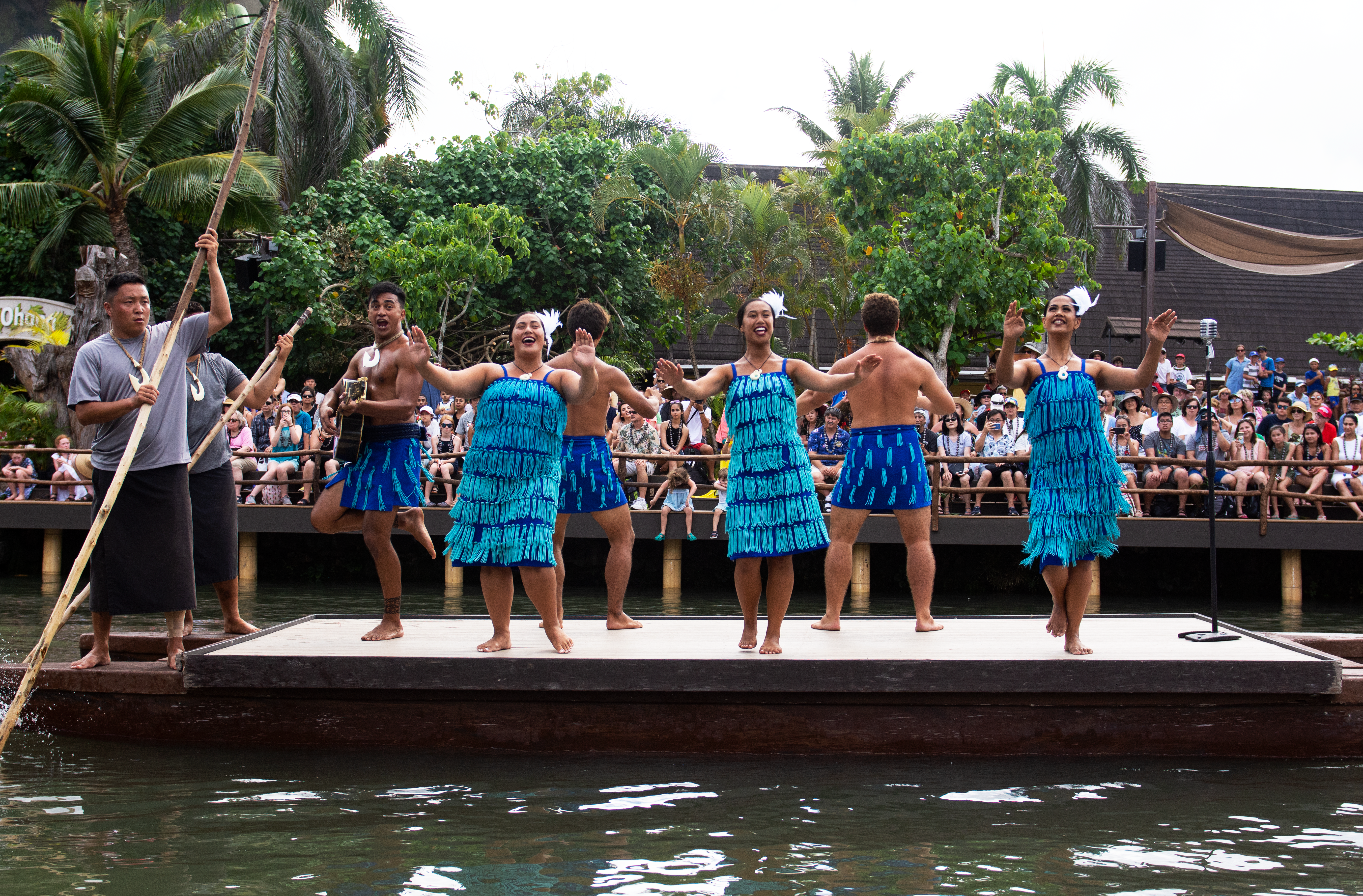
Finished Maori Huki costumes
Meet the transplanted Aussie who oversees PCC costuming
“We’ve used that time to tweak the costuming and tighten up many aspects of the production,” said Roger Ewens, a transplanted Aussie by way of New Zealand. As PCC Manager of Costume Design, he has worked closely with wardrobe supervisor Cathy Teriipaia, Seamstress supervisor Fatai Feinga, and other Huki committee members to help design, produce and maintain over 1,000 new costumes and accessories. When he’s not doing that, he also oversees PCC’s uniform operations.
Ewens, who is originally from Mt. Gambier, SA, Australia, attended Church College of New Zealand, and then served a Latter-day Saint proselyting mission in Manila, The Philippines, before enrolling at Brigham Young University–Hawaii. Like many thousands of BYUH students before and since, he worked part-time at the PCC, including doing design and technical work for the Theater Department. After graduating in fine arts, theater, and travel management in 1986, he returned to Australia for further graduate studies in educational theater as well as Polynesian and Aboriginal studies.
En route to more education in the US mainland in 1991, the PCC drafted him to help design costumes for its canoe show at that time, Legends of Polynesia. He’s been with us ever since.
“As a boy in Australia I never imagined I would be doing this,” Ewens said. He admits, however, he got “chicken skin” the first time he saw a Maori haka (action dance) in New Zealand.
Working closely with PCC cultural specialists
Ewens explained they worked closely with each of the cultural specialists in designing the various costumes used during Huki. He keeps a book which shows how he produced designs and suggested various fabrics. After rounds of feedback, revisions and final approvals, Cathy and Fatai’s teams of artisans and seamstresses, respectively, immediately put those designs into production.
“We would talk about ideas. I’d do designs, and they would go back and forth until eventually, I’d do a final design. We mostly worked with sketches and swatches, coordinating with the seamstresses and wardrobe, who work with adornments like lauhala [pandanus leaves] and shells.”
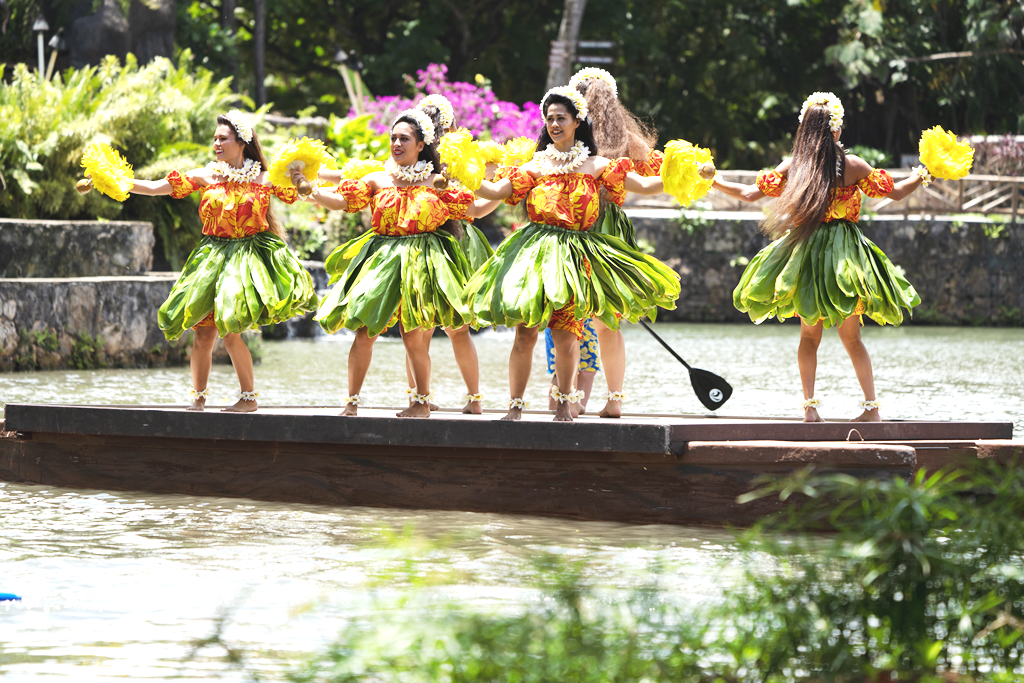
Finished version of the Hawaiian War Chant costumes
Newer technology and outlooks have played a part
“With few exceptions,” Ewens said, “PCC people created all of the costumes and accessories. The seamstresses still play a key role, and our wardrobe department makes most of the accessories and costumes using natural materials. But a lot has changed in the process.”
For example, Ewens recalled when he was a PCC student employee more than 30 years ago, the Theater Department used a makeshift set-up to silk screen custom designs onto bolts of material, which the seamstresses would then sew into costumes.
“Designs are now created by infusing inks into polyester materials,” Ewens continued. “They’re easier to make and maintain. We even use this method for many of our uniforms. We’re constantly experimenting so we can create authentic-looking yet durable costumes that can stand up to daily use and laundering.”
Mixing modern and traditional materials
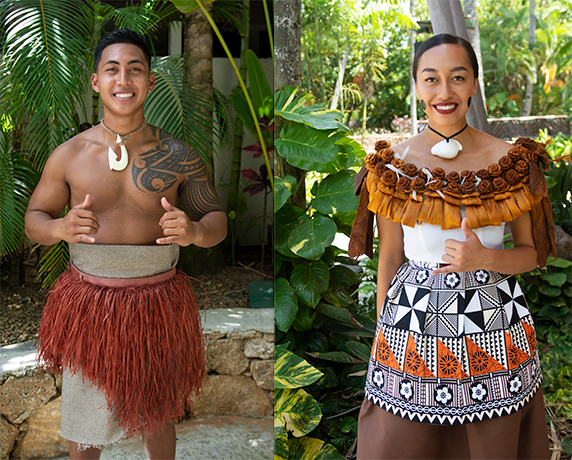
Huki costumes use a combination of materials to provide an authentic feel while being functional.
“In some cases, our wardrobe people strip fabrics, trying to create an authentic ‘feel.’ Of course, we couldn’t use the real materials, because they would not hold up to the repeated performance schedule.”
“In other cases, rather than using real tapa [bark] cloth, we’ve used a thick pellon that we’ve dyed to the color we want. [Pellon is a non-woven fabric usually used to line and/or shape other material.] Then we’ve used bleach to create a pattern in the pellon. The finished results look very organic and authentic.”
Creating an “organic” look
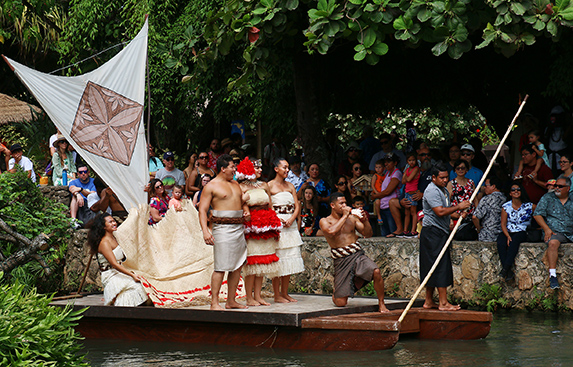
The “organic” look of Samoan costumes at the beginning of Huki. Polynesian Cultural Center cultural advisors charged Ewens with creating an “organic” look that evolves into more distinct Polynesian identities as the production progresses.
The cultural advisors told Ewens “one of the early revisions they wanted was to make the costumes in the beginning part of Huki to look more ‘organic,’ because the people were still all one at that time and hadn’t divided yet into more distinguishable island groups. You’ll see that almost all of the costumes at this point are all in browns and beiges,” he said.
Costumes evolve over history and locations
“While some of the costumes may look similar in the beginning, differences soon emerge. For example, only the Samoans use tuiga [ornate headdresses], and the Fijian men wear a lot of lauhala.”
“The costumes also change with the music.” For example, a female Maori trio sings a 1940s Big Band hit — in Maori. Samoans do their island adaptation of the country-western song Jambalaya. Everyone joins in Elvis Presley’s 1965 adaptation of the PCC’s signature song, Bula Laie, into Drums of the Islands. And another group performs a Christian hymn dressed in typically white going-to-church outfits.
“Consequently, our dancers are frequently dashing ‘off-stage’ and changing into something else. Of course, that’s why we have so many different costumes in Huki. We’ve never done anything like this before,” Ewens said.
“And by the finalé everyone has changed again into blue-themed costumes, representing the ocean which brings us together as one ‘ohana.”
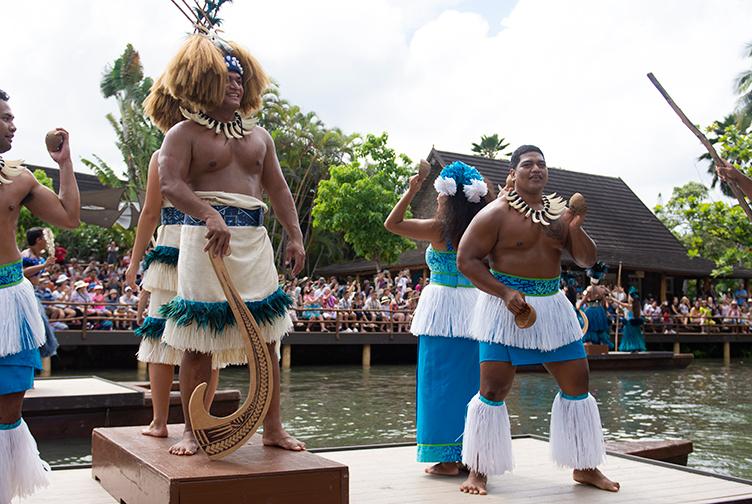
Samoan canoe costumes with blue theme for finale.
Other logistical considerations
Ewens said “PCC seamstresses produce Huki costumes in general sizes — small, medium, large, etc., and each performer generally uses three costumes per show. We also have backup costumes for each ‘role.’ Then, because villagers and guides also help out during Huki, they may also have some additional costuming requirements.”
“After a performance, we send a cart around to the three dressing areas to pick up all the costumes and take them to the laundry to get washed for the next day’s schedule. It’s highly coordinated.” He added he doesn’t know yet, but based on past experiences he hopes each Huki costume will last about six-to-eight months before needing to be replaced.
“The ones using organic materials will have to be replaced sooner. We’re constantly watching the wear-and-tear of the costumes, so they last as long as possible.”
Huki’s blue finalé
Ewens said that creating blue-themed costumes for the finalé was a bit of a challenge. “In every case, we worked with our own cultural experts to make sure the final costumes were culturally correct. Of course, I had some of my own ideas, but they liked what we were creating and felt that I was on track. “For example, Fijians traditionally didn’t use blue tapa [bark cloth], so how could we create something contemporary that looks traditional, and still be respectful to the culture?”
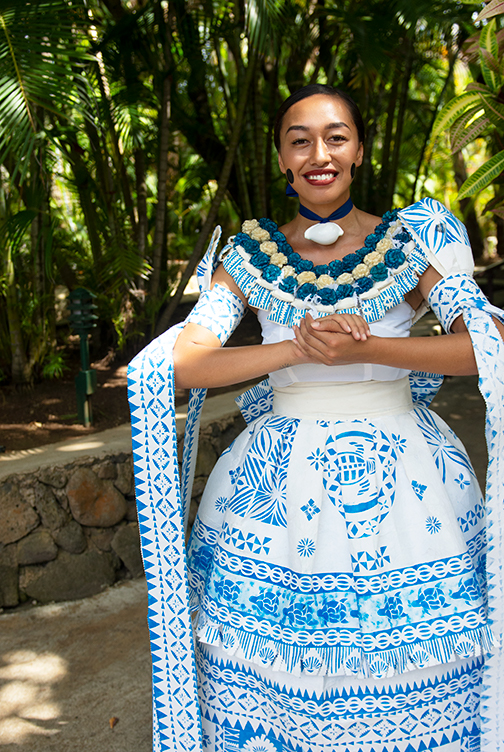
Fiji woman’s dress in final form
He recalled they found a lady in Fiji who was willing to give it a try. “She initially provided us with a tapa she printed using blue ink. We then sent her heavy pellon to print, and everyone here is pleased with those results. I’ve been told the other ladies in Fiji all loved it. Also, now when it rains the ink has already been fused into the pellon, so the color doesn’t run.”
Huki focuses on the Polynesian Cultural Center story
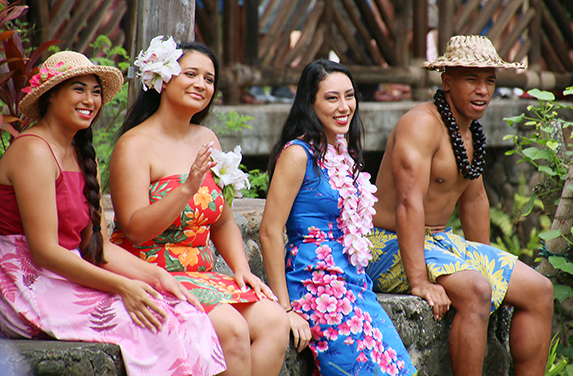
PCC performers reenact part of the 1940s Laie Hukilau, which set the precedent for the establishment of the Polynesian Cultural Center in 1963.
Over the three-year course of planning Huki, the storyline eventually evolved into a loose history of the Polynesian Cultural Center.
“Early on we knew we didn’t want to focus just on dancing,” Ewens said. “From a costuming perspective, I was very pleased we progressed from the beginning where the people were all one. As new influences emerged, they became part of the culture. The people owned them. That’s what we’ve also tried to do with the costuming for Huki. I appreciate being able to pull all these things together in a different light that still says we’re a culture. We’re still alive, and we’re all one. We’re surrounded by the ocean, but we’re all pulling together and we’re part of a family. We’ve come together again at the Polynesian Cultural Center.”
 Story and some photos by Mike Foley, who has been a full-time freelance writer and digital media specialist since 2002. Prior to that, he had a long career in marketing communications, PR, journalism and university education. The Polynesian Cultural Center has used his photos for promotional purposes since the early 1970s. Foley learned to speak fluent Samoan as a Mormon missionary before moving to Laie in 1967, and still does. He has traveled extensively over the years throughout Polynesia, other Pacific islands, and Asia. Though mostly retired now, Foley continues to contribute to PCC and other media.
Story and some photos by Mike Foley, who has been a full-time freelance writer and digital media specialist since 2002. Prior to that, he had a long career in marketing communications, PR, journalism and university education. The Polynesian Cultural Center has used his photos for promotional purposes since the early 1970s. Foley learned to speak fluent Samoan as a Mormon missionary before moving to Laie in 1967, and still does. He has traveled extensively over the years throughout Polynesia, other Pacific islands, and Asia. Though mostly retired now, Foley continues to contribute to PCC and other media.

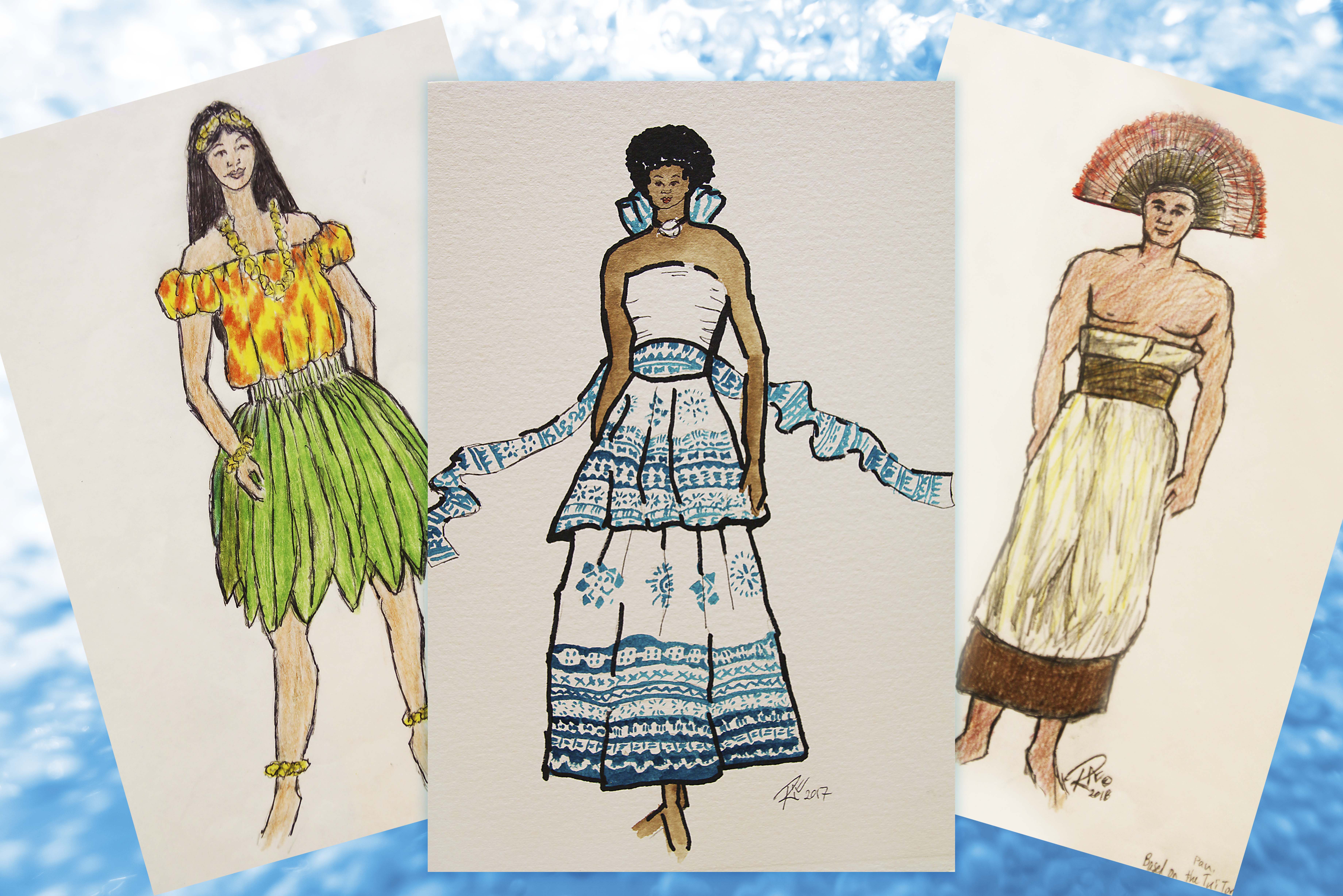
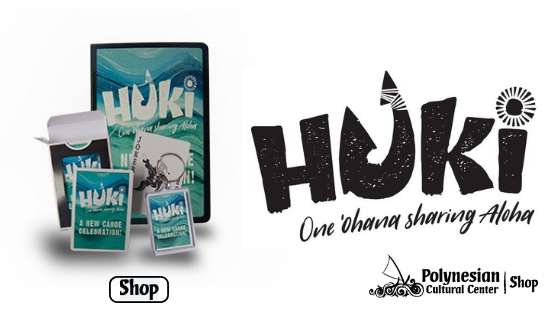
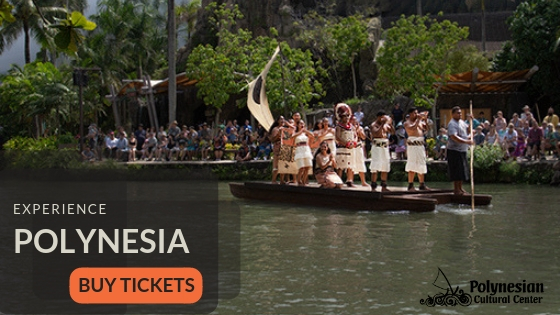
Recent Comments